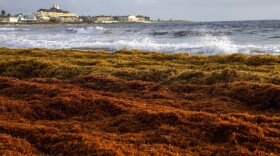-
Meteorologist Megan Borowski discusses the snowfall in the Panhandle. Then, Politco's Gary Fineout previews the Legislature's special session, and NPR’s Sarah McCammon talks about the evangelical right's influence on national policy.
-
Millions of tons of yellow-brown algae that have been swirling about in a region of the tropical Atlantic known as the Sargasso Sea are now breaking loose and landing on Florida shores
-
Researchers from the University of South Florida found last year’s sargassum bloom was so big it posed challenges on a hemispheric scale for marine ecosystems and coastal towns. The size of this upcoming summer’s fledgling bloom is setting records.
-
Potential pilot projects could explore converting sargassum into building material, types of “green” fuel and even an additive that could help reduce beach erosion.
-
A massive sargassum bloom inundated coastlines in Florida and the Caribbean earlier this year. Now, the University of South Florida is leading a $3.2 million grant to bridge a gap in tracking the algae from the open ocean to land.
-
USF researchers who monitor the Great Atlantic Sargassum Belt say they were shocked to see just how much the levels fell last month in the Gulf and Caribbean.
-
Despite the good news, there has still been a profound increase in sargassum in the Atlantic, and thus Florida’s beaches, compared to the early years of the USF study.
-
The floating brown seaweed known as sargassum has exploded in record-setting mass throughout the region. There is increasing commercial and research interest in developing ways to put it to use.
-
From Montego Bay to Miami, sargassum is leaving stinky brown carpets over what was once prime tourist sand. But whether it gets ignored or removed, it comes with high health and environmental risks.
-
13 million tons of seaweed are bobbing off the coast as this year’s Great Atlantic Sargassum Bloom sets new records.
-
A super-swath of brown seaweed is drifting toward Southwest Florida’s beaches, threatening to pile up feet deep in places and stink like rotten eggs.
-
What is sargassum, and is it harmful to our health? We answer these and other questions about the giant blob of seaweed that's making its way to the U.S. east coast.
Play Live Radio
Next Up:
0:00
0:00
Available On Air Stations










